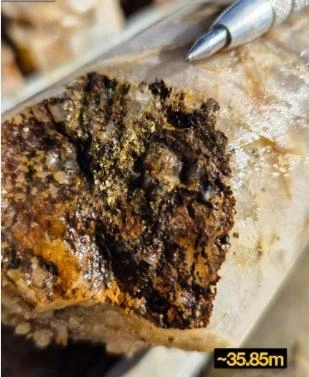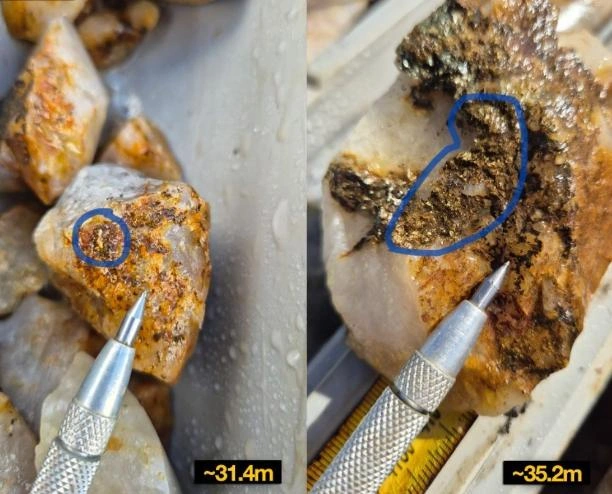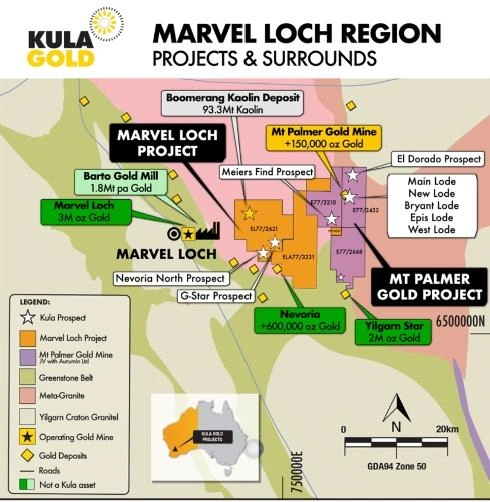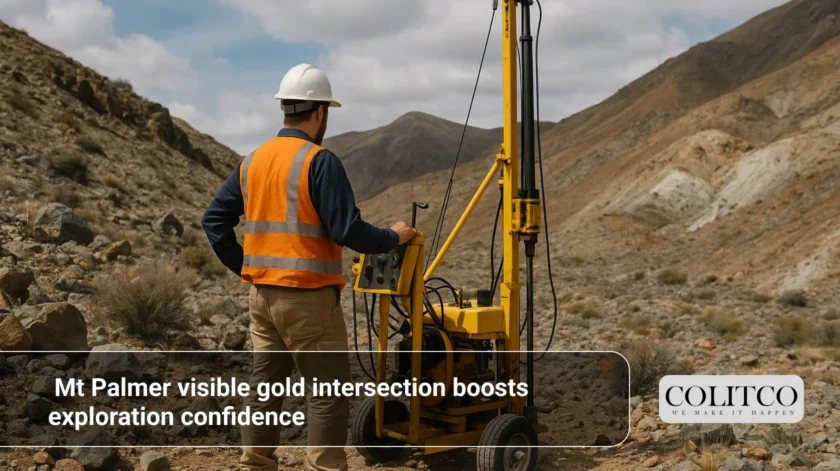Kula Gold Limited announced visible gold intersections in its current diamond drilling campaign at the Mt Palmer Gold Project, Western Australia. This development instills greater confidence in the Company’s strategy of delineating new zones of gold deposits within the Southern Cross Goldfields.

Diamond core drilling in progress at Mt Palmer Gold Project
What did Kula Gold intersect in the latest drilling?
The first hole, 25MPDD001, was drilled to 54 metres. Quartz reefs appeared from 30.1 metres downhole, containing trace sulphides and visible gold.
Visible gold was confirmed at 31.4m, 35.4m, 35.85m, 36.1m, and 36.45m. Assays are pending for this hole.
Kula’s Managing Director, Ric Dawson, stated that the company was “pleased to report the strong visual indications of mineralisation” whilst awaiting assay confirmation.

Visible gold at 35.85m in 25MPDD001 within a 5m shear zone
Why is this Mt Palmer visible gold intersection important?
The presence of visible gold in the diamond drill core is the best evidence for potential high-grade mineralisation. For Kula Gold, the discovery supports the decision to target exploration on quartz-hosted systems at Mt Palmer.
These intersections are consistent with the geological structures that have historically been known to host significant gold manifestations. Structural analysis is ongoing to further resolve the plunge extensions and mineralised zones.
What is the historical significance of the Mt Palmer mine?
The rich mining history of Mt Palmer puts the exploration potential in perspective:
- More than 150,000 ounces of Au were produced at an average grade of 15.9 g/t between 1934 and 1944.
- Mining ceased at the onset of World War II, when many miners relocated to serve, and it never reopened.
- The location is absolutely prospective, surrounded by the Nevoria Gold Mine (over 600,000 ounces) and Marvel Loch (over 3 million ounces).
- The sudden closure presented a significant opportunity for undiscovered orebodies, supported by recent shallow high-grade drill results.

Visible gold in quartz veins at 31.4m (left) and 35.2m (right) in 25MPDD001
What do the Kula Gold Mt Palmer drilling results 2025 show so far?
The HQ3 diamond drilling programme commenced in early September to target several shallow prospects. The drills are expected to take approximately 10 days, with the possibility of adding more holes to the programme.
The core samples will be cut with an Almonte saw and prepared for gold assay, which will take around 2-3 weeks. The assay results of gold will give a more precise idea about the grade, width, and continuity of the mineralisation.
Following this, a bigger RC rig will conduct drilling at deeper extensions of the deposit. This will build a more complete picture of Mt Palmer’s mineral potential.
Kula Gold exploration update September 2025
Such an update confirms visible gold intersections and continued momentum at Mt Palmer:
- First diamond hole 25MPDD001 intersected quartz reefs with visible gold from 30.1m depth.
- Strong visible gold showings observed at multiple intervals, assays awaited.
- HQ3 drilling programme for diamond cores is underway, precipitating shallow prospects; assays expected in 2-3 weeks.
- Bigger RC rig follow-up to diamond drilling to test deeper extensions.
- Great continuation of momentum, and the growth of the resource is confirmed by the update at Mt Palmer.

Kula Gold’s exploration prospects across the Marvel Loch region
How might this development affect investors?
Visible gold often creates interest in the market, yet definitive assays are the core. Pending high-grade assays could result in deep revaluation for Mt Palmer.
From an investor’s stance, having historical production coupled with structural prospectivity and visible gold intersections makes the project attractive enough. The imminent RC drilling might serve to push exploration success further.
Also Read: Kula Gold Aurumin Joint Venture Mt Palmer Strengthened by Partner’s Commitment
FAQs
Q1: What is visible gold, and why is it significant?
Visible gold is native gold seen directly in the drill core. It strongly suggests mineralisation yet needs assays for confirmation.
Q2: When can we expect the assay results?
The turnaround on assay results is in 2 to 3 weeks after sample submission.
Q3: How much did Mt Palmer historically produce?
The historic mine produced 150,000 oz at 15.9 g/t from 1934 to 1944.
Q4: What will follow diamond drilling?
The larger RC drilling program will be carried out to test extensions of deeper mineralisation.












